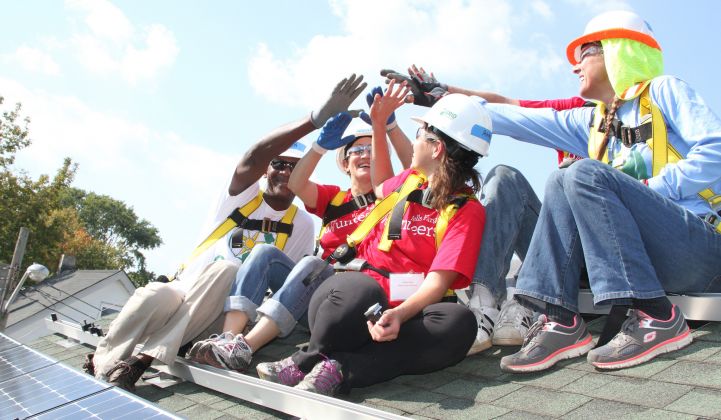In early March, America’s millionth solar installation went on-line, reaching 27 gigawatts of generation capacity across all 50 states and 1 percent of U.S. electricity. This milestone marks solar energy’s mainstream moment. It is also a powerful inflection point to consider how we ensure the next million installations spread solar’s economic benefits to disadvantaged communities.
Solar can provide economic relief for struggling families via lower utility bills and well-paid career opportunities requiring no advanced training. The opportunity to deploy solar and create jobs in underserved communities is huge. Over 6 million affordable housing units currently exist in the U.S., and census data suggests around 22 million owner-occupied households have incomes at or below 80 percent of their area median income.
But it isn’t going to happen by itself. Although solar costs keep falling, dropping 17 percent in 2015 alone, significant barriers to access remain. Upfront costs, housing status, and the economic vulnerability of lower-income families can put solar out of reach for those who stand to benefit most.
Luckily, these issues are surmountable. Federal, state, and local governments and some utilities now see solar as a cost-effective way to provide energy assistance and reduce housing costs, and are developing innovative programs and policies. Momentum is growing in Congress as well. The Low Income Solar Act (S. 1713 and H.R. 3041), introduced in 2015 by Senator Bernie Sanders (D-VT), Representative Tony Cárdenas (D-CA) and others, would provide grants and loans for solar projects in low-income communities.
California led the nation in investing in solar access back in 2006, when it created two ratepayer-funded low-income solar programs aimed at single-family and multifamily housing. Additional funding from the state’s cap-and-trade proceeds were allocated starting in 2015, targeting “environmentally and economically disadvantaged communities.” These programs pair solar installations with workforce training to help people start careers in the nation’s largest solar jobs market. The single-family programs alone have reduced electricity costs by an estimated 75 percent for over 6,500 families, and have provided training for 19,000 individuals.
In Washington, D.C., the city launched a successful program in 2012 to provide solar to income-qualified homeowners using a variety of funding sources, resulting in over 300 installations.
Major efforts are underway at the national level to jump-start solar on multifamily affordable housing through technical assistance and innovative financing. Utility bills are usually the largest and most volatile portion of overall budgets for these developments, and stabilizing costs through solar and energy efficiency can maintain operating budgets, retain tenant services, and avoid raising rents.
The Obama administration recognized the opportunity in 2013 when it included targets for solar on federally assisted housing in the president’s Climate Action Plan. Now renamed Renew300, the initiative aims to add 300 megawatts of solar on affordable housing by 2020. Still, complex funding and regulatory hurdles have slowed progress in this sector.
The newest solar development model may be the most exciting opportunity for delivering clean, affordable power to low-income residents. Community solar, which allows multiple customers to share in a single off-site installation, expands access by removing roof-space requirements, a barrier for renters, apartment dwellers and households with unsuitable roofs. While market-rate community solar generally requires upfront customer investment, dedicated low-income projects can function as direct energy assistance, with developers assuming installation costs and passing the savings to consumers.
Colorado utilities are pioneering low-income community solar projects. The first of its kind was developed last year by Grand Valley Power, a rural electric cooperative in Mesa County, and at least five more are slated for construction in 2016 through a demonstration project with the Colorado Energy Office. While they differ slightly in ownership and rate structure, they commit to lowering energy costs for low-income subscribers by 50 percent or more. These projects, sited in economically struggling rural areas, will also provide solar job training for residents.
All of these efforts are showing dividends, lowering the energy cost burden for low-income families and affordable-housing owners while showing solar is a viable solution in these communities. But they are still piecemeal, dependent on state and local policies, resources and initiatives. If our next million solar installations are going to be equitably distributed across the socioeconomic spectrum, we need to invest in low-income access at a national scale. The Low Income Solar Act is a good start.
***
Erica Mackie is CEO and co-founder of Grid Alternatives.



